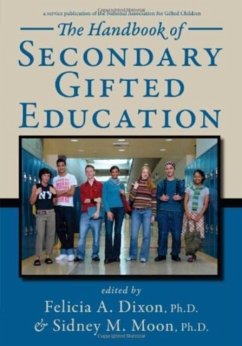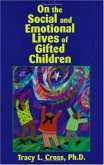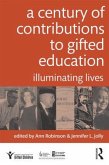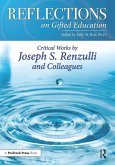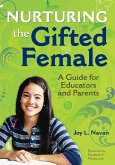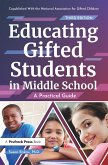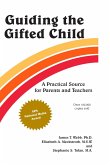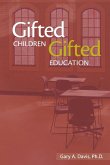Felicia Dixon
The Handbook of Secondary Gifted Education
Felicia Dixon
The Handbook of Secondary Gifted Education
- Broschiertes Buch
- Merkliste
- Auf die Merkliste
- Bewerten Bewerten
- Teilen
- Produkt teilen
- Produkterinnerung
- Produkterinnerung
This ground-breaking textbook is designed to help education professionals interested in building effective and comprehensive educational opportunities for gifted students. The purpose of the book is to provide a research-based handbook that views gifted adolescents and their needs as the starting point for building an effective, integrated educatio
Andere Kunden interessierten sich auch für
![On the Social and Emotional Lives of Gifted Children On the Social and Emotional Lives of Gifted Children]() Tracy L CrossOn the Social and Emotional Lives of Gifted Children18,99 €
Tracy L CrossOn the Social and Emotional Lives of Gifted Children18,99 €![A Century of Contributions to Gifted Education A Century of Contributions to Gifted Education]() A Century of Contributions to Gifted Education72,99 €
A Century of Contributions to Gifted Education72,99 €![Reflections on Gifted Education Reflections on Gifted Education]() Joseph RenzulliReflections on Gifted Education55,99 €
Joseph RenzulliReflections on Gifted Education55,99 €![Nurturing the Gifted Female Nurturing the Gifted Female]() Joy L. NavanNurturing the Gifted Female29,99 €
Joy L. NavanNurturing the Gifted Female29,99 €![Educating Gifted Students in Middle School Educating Gifted Students in Middle School]() Susan RakowEducating Gifted Students in Middle School48,99 €
Susan RakowEducating Gifted Students in Middle School48,99 €![Guiding the Gifted Child Guiding the Gifted Child]() James T WebbGuiding the Gifted Child14,99 €
James T WebbGuiding the Gifted Child14,99 €![Gifted Children and Gifted Education Gifted Children and Gifted Education]() Gary DavisGifted Children and Gifted Education26,99 €
Gary DavisGifted Children and Gifted Education26,99 €-
-
-
This ground-breaking textbook is designed to help education professionals interested in building effective and comprehensive educational opportunities for gifted students. The purpose of the book is to provide a research-based handbook that views gifted adolescents and their needs as the starting point for building an effective, integrated educatio
Produktdetails
- Produktdetails
- Verlag: Routledge
- Seitenzahl: 712
- Erscheinungstermin: 1. November 2005
- Englisch
- ISBN-13: 9781593631789
- ISBN-10: 1593631782
- Artikelnr.: 35662583
- Herstellerkennzeichnung
- Libri GmbH
- Europaallee 1
- 36244 Bad Hersfeld
- gpsr@libri.de
- Verlag: Routledge
- Seitenzahl: 712
- Erscheinungstermin: 1. November 2005
- Englisch
- ISBN-13: 9781593631789
- ISBN-10: 1593631782
- Artikelnr.: 35662583
- Herstellerkennzeichnung
- Libri GmbH
- Europaallee 1
- 36244 Bad Hersfeld
- gpsr@libri.de
Felicia A. Dixon, Ph.D. is associate professor of educational psychology at Ball State University. She directs the master's degree program in educational psychology and the license/endorsement program in gifted education. She received her doctorate from Purdue University and specializes in gifted education. Author of more than 30 articles and chapters, Dr. Dixon received the Early Scholar Award from NAGC in 2004. She is a member of the board of directors of National Association for Gifted Children and is chairperson of the Task Force on Secondary Gifted Education of NAGC.
Introduction Part 1: On Being Gifted and Adolescent On Being Gifted and
Adolescent: An Overview 1. Conceptions of Giftedness in Adolescence
Adolescence Conceptions of Giftedness A Holistic, Developmental Framework
Conclusion References 2. Identity and Career Development in Gifted Students
Erikson's Stages of Psychosocial Development Erikson's Theory of Identity
Development Marcia's Theory of Identity Formation Identity Formation in
Females Identity in Racially Diverse Populations Identity Development in
Gifted Adolescents Career Development of Gifted Adolescents Implications
for Secondary Educators References 3. Social-Emotional Development of
Gifted Adolescents Definitions and Background Counseling and
Social-Emotional Development of Gifted Students Teenage Environment-Family,
Friends, and School Self-Concept College/Career Counseling With Gifted
Students Multipotentiality Underachievement Gifted Students With
Disabilities Summary References 4. Gender, Adolescence, and Giftedness
Gender Role Identity Issues Gender, Adolescence, and Giftedness Teacher
Attitudes and Gender Research About Gender, Giftedness, and Adolescence
Implications for Parents, Teachers, and Counselors Related to Gender and
Adolescence References 5. Being Gifted and Adolescent: Issues and Needs of
Students of Color Background and Definitions Culture: A Brief Overview
Socio-Emotional Issues Facing Gifted Students of Color Psychological Issues
Facing Gifted Students of Color: African Americans as a Case in Point
Implications and Recommendations for Educators and Parents Summary
References 6. Twice-Exceptional Adolescents: Who Are They? What Do They
Need? Who Are Twice-Exceptional Students? What Is it Like to Be
Twice-Exceptional? The Problem Meeting the Needs of Twice-Exceptional
Adolescent Students The Comprehensive Plan Conclusion References 7.
Motivation and Gifted Adolescents Motivated and Gifted Adolescents
Developmental Issues of Adolescence Understanding and Explaining
Motivation: Theories and Research Gifted Students' Motivational Beliefs and
Implications of Those Beliefs Issues and Directions for Future Research
References Part 2: Talent Development in Adolescence Talent Development in
Adolescence: An Overview 8. Understanding Elite Talent in Academic Domains:
A Developmental Trajectory From Basic Abilities to Scholarly
Productivity/Artistry Introduction to the Academic Talent Domain
Domain-Specific Characteristics of Academically Talented Adolescents:
Components of a Developmental Trajectory Model Domain-Specific Talent
Facilitators Domain-Specific Talent Inhibitors Domain-Specific Talent
Development Opportunities Conclusion Appendix A: Internet Resources
References Author Note 9. Development of Visual Arts Talent in Adolescence
by Introduction to Talent in the Visual Arts Defining Talent in the Visual
Arts Characteristics of Adolescents Talented in the Visual Arts Visual Arts
Talent Facilitators Visual and Performing Arts Talent Inhibitors Visual
Arts Talent Development Opportunities Conclusion References 10. Personal
and Social Talent Development Personal Talent Social Talent Development
Conclusion References 11. Talent Development in Sports The Differentiated
Model of Giftedness and Talent The Talent Development Trio The Trio of
Catalysts What Makes the Difference? Conclusion References Part 3: What
Schools Can Do Curriculum and Instruction: An Overview 12. Critical
Thinking: A Foundation for Challenging Content Theoretical Rationale The
Adolescent Experience and Thinking Review of Current Empirical Literature
Strategies Conclusion References 13. Creative Thinking Adolescence and
Adolescents' Need for Creative Expression Theoretical Rationale for
Teaching Creativity to Gifted Adolescents Review of the Current Empirical
Literature Challenging Curriculum Strategies Used to Impart Curriculum
Appropriate Assessment Final Thoughts References 14. Secondary English for
High-Ability Students Theoretical Rationale Review of Current Empirical
Literature Focus of This Chapter Appropriate Strategies for Secondary
Verbally Gifted Students Conclusion References 15. "Pulling the Cat's Tail"
in Social Studies and History Classrooms Student Attitudes Toward Social
Education The Primary Purpose of Social Studies and History Education The
Process of Inquiry Characteristics of Gifted Learners "Pulling the Cat's
Tail" Standards Affecting Quality Differentiation in Social Studies and
History Constructivist Methodology Problem-Based Learning Conclusion
References 16. Guiding Gifted Students Toward Science Expertise Theoretical
Rationale Empirical Research Curriculum Examples: Middle School Curriculum
Examples: High School Picking Among the Projects Instruction in Middle and
High School Assessment Advanced Placement, International Baccalaureate, and
the National Research Council Challenges to Change Facing the Future
References 17. Secondary Mathematics for High-Ability Students Rationale
for Challenging High Level Mathematicians Definition of Mathematical
Giftedness Theoretical Rationale for Teaching Mathematics to Gifted
Adolescents Review of Current Empirical Literature Middle School and High
School Teaching Strategies Challenging Curricula for Middle School and High
School Sample Plan of Study for Gifted Math Students Conclusion References
18. Secondary Affective Curriculum and Instruction for Gifted Learners
Review of Relevant Theory and Research The Integrated Curriculum Model as a
Framework for Affective Curriculum Emotional Intelligence Sample Lesson
Design #1 Sample Lesson Design #2 Sample Lesson Design #3 Sample Lesson
Design #4 Summary of Lessons Writing About Emotions Strategies for Working
With Gifted Secondary Learners on Affective Issues A Model Lesson: The
Socratic Seminar Approach Model Lesson: Literature/Arts Web Model Lesson:
Problem-Based Learning (PBL) Organizing Secondary Curriculum Options
Conclusion References 19. Secondary Program Models and the Evaluation of
Secondary Programs Categories and Descriptions of Models Research and
Evaluations of Effectiveness Selecting Options for Gifted Programs
References 20. Extracurricular Activities General Effects Types of
Extracurricular Activities Competition Extracurricular Activities in the
College Portfolio Finding Balance Extracurricular Activities and Gifted
Students: Recommendations for Educators Future Directions Organizations and
Resources on the Web References 21. Special Schools for the Gifted and
Talented Special Schools for the Gifted Conclusions References Part 4: What
Teacher Education Can Do Professional Development: An Overview 22. Teachers
of Secondary Gifted Students: What Makes Them Effective by Julia Link
Roberts Characteristics and Practices of Effective Teachers Research on
Teacher Effectiveness National Concern About Secondary Teaching What
Effective Teachers of Gifted Students Need to Know, Understand, and Be Able
to Do Recommendations References 23. Preparing Teachers to Work With
High-Ability Youth at the Secondary Level: Issues and Implications for
Licensure Glenn's High School Story Middle School Conversations at
Jefferson Purpose Literature on Teacher Preparation in Gifted
Education From Input Systems to Output Systems in Teacher Preparation: A
Short History Outcomes and Assessments for Teacher Preparation:
Implications for Secondary Teachers Recommended Secondary Content and
Resources for Teacher Preparation Programs Alignment of the Outcomes and
the Assessments References 24. Professional Development for the Education
of Secondary Gifted Students Scenario Defining Professional Development
Guidelines for Expected Competencies Professional Development Components
Rationale for Professional Development Purposes and Goals of Professional
Development Determining the Professional Needs of Potential Professional
Development Participants Participant Involvement in Planning Professional
Development Topics for Professional Development Diversity Issues in
Professional Development Models and Methods of Professional Development
Rural Area Professional Development Formats and Techniques for Professional
Development Evaluation, Follow-Up, and Follow-Through of Professional
Development Sample Professional Development Plans Example One Example Two
Example Three Conclusion References 25. Superintendents, Principals, and
Counselors; Facilitating Secondary Gifted Education Superintendents
Principals School Counselors Conclusion References About the Authors Index
Adolescent: An Overview 1. Conceptions of Giftedness in Adolescence
Adolescence Conceptions of Giftedness A Holistic, Developmental Framework
Conclusion References 2. Identity and Career Development in Gifted Students
Erikson's Stages of Psychosocial Development Erikson's Theory of Identity
Development Marcia's Theory of Identity Formation Identity Formation in
Females Identity in Racially Diverse Populations Identity Development in
Gifted Adolescents Career Development of Gifted Adolescents Implications
for Secondary Educators References 3. Social-Emotional Development of
Gifted Adolescents Definitions and Background Counseling and
Social-Emotional Development of Gifted Students Teenage Environment-Family,
Friends, and School Self-Concept College/Career Counseling With Gifted
Students Multipotentiality Underachievement Gifted Students With
Disabilities Summary References 4. Gender, Adolescence, and Giftedness
Gender Role Identity Issues Gender, Adolescence, and Giftedness Teacher
Attitudes and Gender Research About Gender, Giftedness, and Adolescence
Implications for Parents, Teachers, and Counselors Related to Gender and
Adolescence References 5. Being Gifted and Adolescent: Issues and Needs of
Students of Color Background and Definitions Culture: A Brief Overview
Socio-Emotional Issues Facing Gifted Students of Color Psychological Issues
Facing Gifted Students of Color: African Americans as a Case in Point
Implications and Recommendations for Educators and Parents Summary
References 6. Twice-Exceptional Adolescents: Who Are They? What Do They
Need? Who Are Twice-Exceptional Students? What Is it Like to Be
Twice-Exceptional? The Problem Meeting the Needs of Twice-Exceptional
Adolescent Students The Comprehensive Plan Conclusion References 7.
Motivation and Gifted Adolescents Motivated and Gifted Adolescents
Developmental Issues of Adolescence Understanding and Explaining
Motivation: Theories and Research Gifted Students' Motivational Beliefs and
Implications of Those Beliefs Issues and Directions for Future Research
References Part 2: Talent Development in Adolescence Talent Development in
Adolescence: An Overview 8. Understanding Elite Talent in Academic Domains:
A Developmental Trajectory From Basic Abilities to Scholarly
Productivity/Artistry Introduction to the Academic Talent Domain
Domain-Specific Characteristics of Academically Talented Adolescents:
Components of a Developmental Trajectory Model Domain-Specific Talent
Facilitators Domain-Specific Talent Inhibitors Domain-Specific Talent
Development Opportunities Conclusion Appendix A: Internet Resources
References Author Note 9. Development of Visual Arts Talent in Adolescence
by Introduction to Talent in the Visual Arts Defining Talent in the Visual
Arts Characteristics of Adolescents Talented in the Visual Arts Visual Arts
Talent Facilitators Visual and Performing Arts Talent Inhibitors Visual
Arts Talent Development Opportunities Conclusion References 10. Personal
and Social Talent Development Personal Talent Social Talent Development
Conclusion References 11. Talent Development in Sports The Differentiated
Model of Giftedness and Talent The Talent Development Trio The Trio of
Catalysts What Makes the Difference? Conclusion References Part 3: What
Schools Can Do Curriculum and Instruction: An Overview 12. Critical
Thinking: A Foundation for Challenging Content Theoretical Rationale The
Adolescent Experience and Thinking Review of Current Empirical Literature
Strategies Conclusion References 13. Creative Thinking Adolescence and
Adolescents' Need for Creative Expression Theoretical Rationale for
Teaching Creativity to Gifted Adolescents Review of the Current Empirical
Literature Challenging Curriculum Strategies Used to Impart Curriculum
Appropriate Assessment Final Thoughts References 14. Secondary English for
High-Ability Students Theoretical Rationale Review of Current Empirical
Literature Focus of This Chapter Appropriate Strategies for Secondary
Verbally Gifted Students Conclusion References 15. "Pulling the Cat's Tail"
in Social Studies and History Classrooms Student Attitudes Toward Social
Education The Primary Purpose of Social Studies and History Education The
Process of Inquiry Characteristics of Gifted Learners "Pulling the Cat's
Tail" Standards Affecting Quality Differentiation in Social Studies and
History Constructivist Methodology Problem-Based Learning Conclusion
References 16. Guiding Gifted Students Toward Science Expertise Theoretical
Rationale Empirical Research Curriculum Examples: Middle School Curriculum
Examples: High School Picking Among the Projects Instruction in Middle and
High School Assessment Advanced Placement, International Baccalaureate, and
the National Research Council Challenges to Change Facing the Future
References 17. Secondary Mathematics for High-Ability Students Rationale
for Challenging High Level Mathematicians Definition of Mathematical
Giftedness Theoretical Rationale for Teaching Mathematics to Gifted
Adolescents Review of Current Empirical Literature Middle School and High
School Teaching Strategies Challenging Curricula for Middle School and High
School Sample Plan of Study for Gifted Math Students Conclusion References
18. Secondary Affective Curriculum and Instruction for Gifted Learners
Review of Relevant Theory and Research The Integrated Curriculum Model as a
Framework for Affective Curriculum Emotional Intelligence Sample Lesson
Design #1 Sample Lesson Design #2 Sample Lesson Design #3 Sample Lesson
Design #4 Summary of Lessons Writing About Emotions Strategies for Working
With Gifted Secondary Learners on Affective Issues A Model Lesson: The
Socratic Seminar Approach Model Lesson: Literature/Arts Web Model Lesson:
Problem-Based Learning (PBL) Organizing Secondary Curriculum Options
Conclusion References 19. Secondary Program Models and the Evaluation of
Secondary Programs Categories and Descriptions of Models Research and
Evaluations of Effectiveness Selecting Options for Gifted Programs
References 20. Extracurricular Activities General Effects Types of
Extracurricular Activities Competition Extracurricular Activities in the
College Portfolio Finding Balance Extracurricular Activities and Gifted
Students: Recommendations for Educators Future Directions Organizations and
Resources on the Web References 21. Special Schools for the Gifted and
Talented Special Schools for the Gifted Conclusions References Part 4: What
Teacher Education Can Do Professional Development: An Overview 22. Teachers
of Secondary Gifted Students: What Makes Them Effective by Julia Link
Roberts Characteristics and Practices of Effective Teachers Research on
Teacher Effectiveness National Concern About Secondary Teaching What
Effective Teachers of Gifted Students Need to Know, Understand, and Be Able
to Do Recommendations References 23. Preparing Teachers to Work With
High-Ability Youth at the Secondary Level: Issues and Implications for
Licensure Glenn's High School Story Middle School Conversations at
Jefferson Purpose Literature on Teacher Preparation in Gifted
Education From Input Systems to Output Systems in Teacher Preparation: A
Short History Outcomes and Assessments for Teacher Preparation:
Implications for Secondary Teachers Recommended Secondary Content and
Resources for Teacher Preparation Programs Alignment of the Outcomes and
the Assessments References 24. Professional Development for the Education
of Secondary Gifted Students Scenario Defining Professional Development
Guidelines for Expected Competencies Professional Development Components
Rationale for Professional Development Purposes and Goals of Professional
Development Determining the Professional Needs of Potential Professional
Development Participants Participant Involvement in Planning Professional
Development Topics for Professional Development Diversity Issues in
Professional Development Models and Methods of Professional Development
Rural Area Professional Development Formats and Techniques for Professional
Development Evaluation, Follow-Up, and Follow-Through of Professional
Development Sample Professional Development Plans Example One Example Two
Example Three Conclusion References 25. Superintendents, Principals, and
Counselors; Facilitating Secondary Gifted Education Superintendents
Principals School Counselors Conclusion References About the Authors Index
Introduction Part 1: On Being Gifted and Adolescent On Being Gifted and
Adolescent: An Overview 1. Conceptions of Giftedness in Adolescence
Adolescence Conceptions of Giftedness A Holistic, Developmental Framework
Conclusion References 2. Identity and Career Development in Gifted Students
Erikson's Stages of Psychosocial Development Erikson's Theory of Identity
Development Marcia's Theory of Identity Formation Identity Formation in
Females Identity in Racially Diverse Populations Identity Development in
Gifted Adolescents Career Development of Gifted Adolescents Implications
for Secondary Educators References 3. Social-Emotional Development of
Gifted Adolescents Definitions and Background Counseling and
Social-Emotional Development of Gifted Students Teenage Environment-Family,
Friends, and School Self-Concept College/Career Counseling With Gifted
Students Multipotentiality Underachievement Gifted Students With
Disabilities Summary References 4. Gender, Adolescence, and Giftedness
Gender Role Identity Issues Gender, Adolescence, and Giftedness Teacher
Attitudes and Gender Research About Gender, Giftedness, and Adolescence
Implications for Parents, Teachers, and Counselors Related to Gender and
Adolescence References 5. Being Gifted and Adolescent: Issues and Needs of
Students of Color Background and Definitions Culture: A Brief Overview
Socio-Emotional Issues Facing Gifted Students of Color Psychological Issues
Facing Gifted Students of Color: African Americans as a Case in Point
Implications and Recommendations for Educators and Parents Summary
References 6. Twice-Exceptional Adolescents: Who Are They? What Do They
Need? Who Are Twice-Exceptional Students? What Is it Like to Be
Twice-Exceptional? The Problem Meeting the Needs of Twice-Exceptional
Adolescent Students The Comprehensive Plan Conclusion References 7.
Motivation and Gifted Adolescents Motivated and Gifted Adolescents
Developmental Issues of Adolescence Understanding and Explaining
Motivation: Theories and Research Gifted Students' Motivational Beliefs and
Implications of Those Beliefs Issues and Directions for Future Research
References Part 2: Talent Development in Adolescence Talent Development in
Adolescence: An Overview 8. Understanding Elite Talent in Academic Domains:
A Developmental Trajectory From Basic Abilities to Scholarly
Productivity/Artistry Introduction to the Academic Talent Domain
Domain-Specific Characteristics of Academically Talented Adolescents:
Components of a Developmental Trajectory Model Domain-Specific Talent
Facilitators Domain-Specific Talent Inhibitors Domain-Specific Talent
Development Opportunities Conclusion Appendix A: Internet Resources
References Author Note 9. Development of Visual Arts Talent in Adolescence
by Introduction to Talent in the Visual Arts Defining Talent in the Visual
Arts Characteristics of Adolescents Talented in the Visual Arts Visual Arts
Talent Facilitators Visual and Performing Arts Talent Inhibitors Visual
Arts Talent Development Opportunities Conclusion References 10. Personal
and Social Talent Development Personal Talent Social Talent Development
Conclusion References 11. Talent Development in Sports The Differentiated
Model of Giftedness and Talent The Talent Development Trio The Trio of
Catalysts What Makes the Difference? Conclusion References Part 3: What
Schools Can Do Curriculum and Instruction: An Overview 12. Critical
Thinking: A Foundation for Challenging Content Theoretical Rationale The
Adolescent Experience and Thinking Review of Current Empirical Literature
Strategies Conclusion References 13. Creative Thinking Adolescence and
Adolescents' Need for Creative Expression Theoretical Rationale for
Teaching Creativity to Gifted Adolescents Review of the Current Empirical
Literature Challenging Curriculum Strategies Used to Impart Curriculum
Appropriate Assessment Final Thoughts References 14. Secondary English for
High-Ability Students Theoretical Rationale Review of Current Empirical
Literature Focus of This Chapter Appropriate Strategies for Secondary
Verbally Gifted Students Conclusion References 15. "Pulling the Cat's Tail"
in Social Studies and History Classrooms Student Attitudes Toward Social
Education The Primary Purpose of Social Studies and History Education The
Process of Inquiry Characteristics of Gifted Learners "Pulling the Cat's
Tail" Standards Affecting Quality Differentiation in Social Studies and
History Constructivist Methodology Problem-Based Learning Conclusion
References 16. Guiding Gifted Students Toward Science Expertise Theoretical
Rationale Empirical Research Curriculum Examples: Middle School Curriculum
Examples: High School Picking Among the Projects Instruction in Middle and
High School Assessment Advanced Placement, International Baccalaureate, and
the National Research Council Challenges to Change Facing the Future
References 17. Secondary Mathematics for High-Ability Students Rationale
for Challenging High Level Mathematicians Definition of Mathematical
Giftedness Theoretical Rationale for Teaching Mathematics to Gifted
Adolescents Review of Current Empirical Literature Middle School and High
School Teaching Strategies Challenging Curricula for Middle School and High
School Sample Plan of Study for Gifted Math Students Conclusion References
18. Secondary Affective Curriculum and Instruction for Gifted Learners
Review of Relevant Theory and Research The Integrated Curriculum Model as a
Framework for Affective Curriculum Emotional Intelligence Sample Lesson
Design #1 Sample Lesson Design #2 Sample Lesson Design #3 Sample Lesson
Design #4 Summary of Lessons Writing About Emotions Strategies for Working
With Gifted Secondary Learners on Affective Issues A Model Lesson: The
Socratic Seminar Approach Model Lesson: Literature/Arts Web Model Lesson:
Problem-Based Learning (PBL) Organizing Secondary Curriculum Options
Conclusion References 19. Secondary Program Models and the Evaluation of
Secondary Programs Categories and Descriptions of Models Research and
Evaluations of Effectiveness Selecting Options for Gifted Programs
References 20. Extracurricular Activities General Effects Types of
Extracurricular Activities Competition Extracurricular Activities in the
College Portfolio Finding Balance Extracurricular Activities and Gifted
Students: Recommendations for Educators Future Directions Organizations and
Resources on the Web References 21. Special Schools for the Gifted and
Talented Special Schools for the Gifted Conclusions References Part 4: What
Teacher Education Can Do Professional Development: An Overview 22. Teachers
of Secondary Gifted Students: What Makes Them Effective by Julia Link
Roberts Characteristics and Practices of Effective Teachers Research on
Teacher Effectiveness National Concern About Secondary Teaching What
Effective Teachers of Gifted Students Need to Know, Understand, and Be Able
to Do Recommendations References 23. Preparing Teachers to Work With
High-Ability Youth at the Secondary Level: Issues and Implications for
Licensure Glenn's High School Story Middle School Conversations at
Jefferson Purpose Literature on Teacher Preparation in Gifted
Education From Input Systems to Output Systems in Teacher Preparation: A
Short History Outcomes and Assessments for Teacher Preparation:
Implications for Secondary Teachers Recommended Secondary Content and
Resources for Teacher Preparation Programs Alignment of the Outcomes and
the Assessments References 24. Professional Development for the Education
of Secondary Gifted Students Scenario Defining Professional Development
Guidelines for Expected Competencies Professional Development Components
Rationale for Professional Development Purposes and Goals of Professional
Development Determining the Professional Needs of Potential Professional
Development Participants Participant Involvement in Planning Professional
Development Topics for Professional Development Diversity Issues in
Professional Development Models and Methods of Professional Development
Rural Area Professional Development Formats and Techniques for Professional
Development Evaluation, Follow-Up, and Follow-Through of Professional
Development Sample Professional Development Plans Example One Example Two
Example Three Conclusion References 25. Superintendents, Principals, and
Counselors; Facilitating Secondary Gifted Education Superintendents
Principals School Counselors Conclusion References About the Authors Index
Adolescent: An Overview 1. Conceptions of Giftedness in Adolescence
Adolescence Conceptions of Giftedness A Holistic, Developmental Framework
Conclusion References 2. Identity and Career Development in Gifted Students
Erikson's Stages of Psychosocial Development Erikson's Theory of Identity
Development Marcia's Theory of Identity Formation Identity Formation in
Females Identity in Racially Diverse Populations Identity Development in
Gifted Adolescents Career Development of Gifted Adolescents Implications
for Secondary Educators References 3. Social-Emotional Development of
Gifted Adolescents Definitions and Background Counseling and
Social-Emotional Development of Gifted Students Teenage Environment-Family,
Friends, and School Self-Concept College/Career Counseling With Gifted
Students Multipotentiality Underachievement Gifted Students With
Disabilities Summary References 4. Gender, Adolescence, and Giftedness
Gender Role Identity Issues Gender, Adolescence, and Giftedness Teacher
Attitudes and Gender Research About Gender, Giftedness, and Adolescence
Implications for Parents, Teachers, and Counselors Related to Gender and
Adolescence References 5. Being Gifted and Adolescent: Issues and Needs of
Students of Color Background and Definitions Culture: A Brief Overview
Socio-Emotional Issues Facing Gifted Students of Color Psychological Issues
Facing Gifted Students of Color: African Americans as a Case in Point
Implications and Recommendations for Educators and Parents Summary
References 6. Twice-Exceptional Adolescents: Who Are They? What Do They
Need? Who Are Twice-Exceptional Students? What Is it Like to Be
Twice-Exceptional? The Problem Meeting the Needs of Twice-Exceptional
Adolescent Students The Comprehensive Plan Conclusion References 7.
Motivation and Gifted Adolescents Motivated and Gifted Adolescents
Developmental Issues of Adolescence Understanding and Explaining
Motivation: Theories and Research Gifted Students' Motivational Beliefs and
Implications of Those Beliefs Issues and Directions for Future Research
References Part 2: Talent Development in Adolescence Talent Development in
Adolescence: An Overview 8. Understanding Elite Talent in Academic Domains:
A Developmental Trajectory From Basic Abilities to Scholarly
Productivity/Artistry Introduction to the Academic Talent Domain
Domain-Specific Characteristics of Academically Talented Adolescents:
Components of a Developmental Trajectory Model Domain-Specific Talent
Facilitators Domain-Specific Talent Inhibitors Domain-Specific Talent
Development Opportunities Conclusion Appendix A: Internet Resources
References Author Note 9. Development of Visual Arts Talent in Adolescence
by Introduction to Talent in the Visual Arts Defining Talent in the Visual
Arts Characteristics of Adolescents Talented in the Visual Arts Visual Arts
Talent Facilitators Visual and Performing Arts Talent Inhibitors Visual
Arts Talent Development Opportunities Conclusion References 10. Personal
and Social Talent Development Personal Talent Social Talent Development
Conclusion References 11. Talent Development in Sports The Differentiated
Model of Giftedness and Talent The Talent Development Trio The Trio of
Catalysts What Makes the Difference? Conclusion References Part 3: What
Schools Can Do Curriculum and Instruction: An Overview 12. Critical
Thinking: A Foundation for Challenging Content Theoretical Rationale The
Adolescent Experience and Thinking Review of Current Empirical Literature
Strategies Conclusion References 13. Creative Thinking Adolescence and
Adolescents' Need for Creative Expression Theoretical Rationale for
Teaching Creativity to Gifted Adolescents Review of the Current Empirical
Literature Challenging Curriculum Strategies Used to Impart Curriculum
Appropriate Assessment Final Thoughts References 14. Secondary English for
High-Ability Students Theoretical Rationale Review of Current Empirical
Literature Focus of This Chapter Appropriate Strategies for Secondary
Verbally Gifted Students Conclusion References 15. "Pulling the Cat's Tail"
in Social Studies and History Classrooms Student Attitudes Toward Social
Education The Primary Purpose of Social Studies and History Education The
Process of Inquiry Characteristics of Gifted Learners "Pulling the Cat's
Tail" Standards Affecting Quality Differentiation in Social Studies and
History Constructivist Methodology Problem-Based Learning Conclusion
References 16. Guiding Gifted Students Toward Science Expertise Theoretical
Rationale Empirical Research Curriculum Examples: Middle School Curriculum
Examples: High School Picking Among the Projects Instruction in Middle and
High School Assessment Advanced Placement, International Baccalaureate, and
the National Research Council Challenges to Change Facing the Future
References 17. Secondary Mathematics for High-Ability Students Rationale
for Challenging High Level Mathematicians Definition of Mathematical
Giftedness Theoretical Rationale for Teaching Mathematics to Gifted
Adolescents Review of Current Empirical Literature Middle School and High
School Teaching Strategies Challenging Curricula for Middle School and High
School Sample Plan of Study for Gifted Math Students Conclusion References
18. Secondary Affective Curriculum and Instruction for Gifted Learners
Review of Relevant Theory and Research The Integrated Curriculum Model as a
Framework for Affective Curriculum Emotional Intelligence Sample Lesson
Design #1 Sample Lesson Design #2 Sample Lesson Design #3 Sample Lesson
Design #4 Summary of Lessons Writing About Emotions Strategies for Working
With Gifted Secondary Learners on Affective Issues A Model Lesson: The
Socratic Seminar Approach Model Lesson: Literature/Arts Web Model Lesson:
Problem-Based Learning (PBL) Organizing Secondary Curriculum Options
Conclusion References 19. Secondary Program Models and the Evaluation of
Secondary Programs Categories and Descriptions of Models Research and
Evaluations of Effectiveness Selecting Options for Gifted Programs
References 20. Extracurricular Activities General Effects Types of
Extracurricular Activities Competition Extracurricular Activities in the
College Portfolio Finding Balance Extracurricular Activities and Gifted
Students: Recommendations for Educators Future Directions Organizations and
Resources on the Web References 21. Special Schools for the Gifted and
Talented Special Schools for the Gifted Conclusions References Part 4: What
Teacher Education Can Do Professional Development: An Overview 22. Teachers
of Secondary Gifted Students: What Makes Them Effective by Julia Link
Roberts Characteristics and Practices of Effective Teachers Research on
Teacher Effectiveness National Concern About Secondary Teaching What
Effective Teachers of Gifted Students Need to Know, Understand, and Be Able
to Do Recommendations References 23. Preparing Teachers to Work With
High-Ability Youth at the Secondary Level: Issues and Implications for
Licensure Glenn's High School Story Middle School Conversations at
Jefferson Purpose Literature on Teacher Preparation in Gifted
Education From Input Systems to Output Systems in Teacher Preparation: A
Short History Outcomes and Assessments for Teacher Preparation:
Implications for Secondary Teachers Recommended Secondary Content and
Resources for Teacher Preparation Programs Alignment of the Outcomes and
the Assessments References 24. Professional Development for the Education
of Secondary Gifted Students Scenario Defining Professional Development
Guidelines for Expected Competencies Professional Development Components
Rationale for Professional Development Purposes and Goals of Professional
Development Determining the Professional Needs of Potential Professional
Development Participants Participant Involvement in Planning Professional
Development Topics for Professional Development Diversity Issues in
Professional Development Models and Methods of Professional Development
Rural Area Professional Development Formats and Techniques for Professional
Development Evaluation, Follow-Up, and Follow-Through of Professional
Development Sample Professional Development Plans Example One Example Two
Example Three Conclusion References 25. Superintendents, Principals, and
Counselors; Facilitating Secondary Gifted Education Superintendents
Principals School Counselors Conclusion References About the Authors Index

